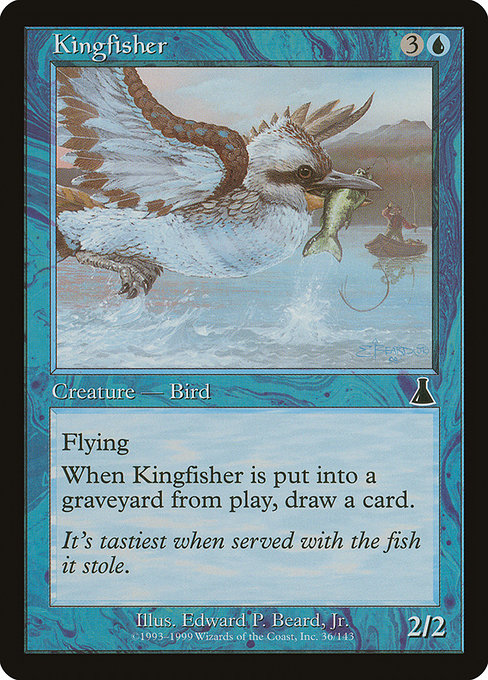
Image courtesy of Scryfall.com
Artful Design vs Card Efficiency: Kingfisher in the blue balance act
Blue has long been a color that channels both elegance and exacting calculation, and Kingfisher stands as a compact capsule of that philosophy. Released in Urza’s Destiny, a set that fanned the flames of artifact-powered tempo and clever creature tricks, this common blue Bird costs 3 generic and 1 blue mana (total mana cost {3}{U}) for a modest 2/2 with flying. On the surface, that stat line isn’t breaking any speed records, but the real magic lives in its death trigger: when this creature dies, draw a card. The elegance here is in the pairing—evasion by flying, a sturdy body for the cost, and a value engine that only activates when the creature meets its end. It’s a tiny sermon on why artful design can elevate even ordinary cards. 🧙♂️🔥
Consider the flavor text and the artwork together: the Kingfisher’s sleek blue plumage and swift silhouette hint at precision and strategy, while the flavor line—"It's tastiest when served with the fish it stole"—gives the card a sly personality that resonates with blue’s penchant for cunning, control, and resourcefulness. The illustration, by Edward P. Beard Jr., captures a bird that looks both graceful and opportunistic, a perfect visual metaphor for a card that trades raw speed for strategic card advantage. The tension between beauty and practicality isn’t unique to a single card—it’s baked into countless design decisions across MTG’s history. Still, Kingfisher crystallizes the balance with a crisp, memorable bite. 🎨⚔️
It's tastiest when served with the fish it stole.
From a purely mechanical lens, Kingfisher embodies the artful craft of card design. Flying ensures it can threaten when left unanswered, while the Death trigger creates inevitability: if an opponent wants to answer it, they’ll pay the removal cost, and in the meanwhile you’ve exchanged a vulnerable mana investment for a card you’ll draw later. That dynamic—presence, pressure, and a built-in option to turn a doom into value—narrates a timeless design dilemma: is speed the currency of power, or can slow burn, memory, and inevitability win the day? Kingfisher leans toward the latter, rewarding patience and planning more than brute force. The card’s rarity (common) and its era (late 1990s) also remind us how designers once leaned into solid, repeatable effects that could anchor diverse blue decks for years to come. 🧭💎
How Kingfisher informs the broader art-vs-efficiency conversation
Today’s card design often balances flashy ability text with lasting impact, but older designs like Kingfisher teach a powerful lesson: memorable flavor and clean mechanics don’t have to shout to be effective. A single, well-chosen line of text can punch above its weight if the surrounding frame—mana cost, creature type, and color identity—supports a coherent strategy. In Kingfisher’s case, the choice to grant Flying and pair it with a card-drawing death trigger creates a ripple effect that resonates with blue’s core themes: evasive pressure, incremental advantage, and resilient answers to disruption. Even as meta shifts bring newer, flashier tools to the table, the card remains a touchstone for how artful restraint can yield genuine gameplay value. 🧙♂️🎲
Strategically, Kingfisher shines in decks that prize tempo and late-game inevitability. In Commander formats that legalize its color pair, or in Vintage and Legacy ecosystems where its blue siblings can protect and provoke, the ability to draw a card after death plays nicely with sacrifice outlets, recursion, and bulky removal suites. It’s not a bomb, but it is a thoughtful piece that rewards strategic planning: protect your life total, chip away at the board with evasive threats, and savor the incidental card draw when the bird finally meets its doom. This is not about raw numbers; it’s about how a single line of text nudges you toward a particular rhythm of play. 🧠🎯
For deck builders and lore lovers alike, the Kingfisher saga also serves as a reminder that art and utility can walk hand in hand. The artwork’s kinetic vitality complements the mechanical “kill to draw” motif, turning a plain 4-mana creature into a small, elegant argument for why blue can be both beautiful and practical. And if you’re hunting for a desk companion that keeps you sharp while you map out card interactions, a sturdy mouse pad can be your silent ally—especially when you’re navigating decklists, combos, and sideboard decisions late into the night. (Pro tip: a reliable surface helps you line up your next play with confidence. 🧙♂️💻)
Speaking of setup, a few practical notes: Kingfisher’s modern relevance isn’t about chasing new combos, but about recognizing how classic design informs contemporary expectations. It reminds us that a card’s power can be rooted in its timing and its relationship to other cards, not just its raw stats. That insight matters whether you’re drafting a nostalgic blue tempo shell or evaluating the aesthetic choices that artists, editors, and designers blend into a single, cohesive product. The elegance is in the restraint—the art, the text, the timing—and the payoff is in the quiet, repeated value of card draw when the bird finally falls. 🧙♂️🔥
Non-slip gaming mouse pad 9.5x8in anti-fray rubber baseWhile you mull over the delicate balance of form and function in a vintage blue creature, you might also enjoy keeping your workspace sharp and steady with a dependable mouse pad. It’s a small edge that matters when you’re counting cards and weighing lines of play across a crowded table or a marathon online session. 🧙♂️🎲
More from our network
- https://crypto-acolytes.xyz/blog/post/mitigating-impermanent-loss-risks-on-solana-defi-platforms/
- https://blog.digital-vault.xyz/blog/post/nightsquad-commando-secondary-market-data-analysis/
- https://transparent-paper.shop/blog/post/how-to-create-digital-texture-brushes-in-procreate/
- https://blog.digital-vault.xyz/blog/post/mass-flame-and-stellar-mass-estimation-in-a-distant-blue-star/
- https://blog.digital-vault.xyz/blog/post/mastering-cast-down-threat-assessment-on-noncreature-permanents/